#but they have an unfortunate amount of superficial overlap
Note
Oh i thought because you like ancient Greek mythology you would like neoclassicism. But of course it's not the same because the ancient Greek marbles were extraordinary and inspired the neoclassicism which was European but unfortunately Greeks were participated in this :(
I think the question was what I find interesting, not what I like. I like a lot of things that I don't find interesting, and lot of things I don't like catch my interest.
however, I did include neoclassicism in my answer, as partly overlapping/ being included in academic art, but not because of its rather superficial relation to ancient greek mythology or ancient greece. I really like observing the skill and knowledge it showcases, so that's why it is interesting to me.
I like a lot of ancient greek art in the same way that I like all art, that is to say, sometimes because of the concept (be is something funny or unique etc) , sometimes because it's stylized in a way that I enjoy, sometimes because I admire the skill, and sometimes because it's showing me something interesting, like pottery drawings that show mundane every day things.
The vast majority of art we have from anceint greece as a whole isn't like hermes of praxiteles or the doryphoros or any other masterpiece. Masterpieces were and still are few and far between, in general. Drawing and painting in europe after the rennaisance was miles ahead of ancient greek drawing and painting in terms of skill.
I don't see anything particularly extraordinary about ancient greek sculpture specifically, the same type of masterpieces were made in rome later, in the rennaisance and even nowadays, whenever artists had enough resources and the overall art climate was leaning towards more realistic renderings. The artists back then and the artists now are the same type of human. It so happened that in an area with excellent climate, wealth sources such as silver mines and overseas trade and a frankly huge amount of easily available marble, as well as political and social curcumstances that nurished the arts, this type of sculpture was developed and flourished, but drawing on centuries of experience, and prior influence from the monumental works of the ancient egyptians, at the very beginning.
that's all to say that I don't think it's good to have an idealised idea of ancient greek art and we need to shake that way of thinking off asap. We must go to a museum and look at all the things, not just the 2 famous, exceptional exhibits, if we want to talk about an entire culture's (or often, slightly different sub culutures included in the same overall category) artwork. That pottery piece with the funny hoplite owl means so much more to me than the aphrodite of melos, who I frankly neither like as an art piece nor care about (and that's fine because we all have our completely subjective preferences for art), and the overwhelming majority of art from minoan to hellenistic times leans more towards the first in terms of what I would call measurable skill for lack of a better word.
TL:DR
That's an inexcusably long rant form my part to say that I don't think the neoclassical masterpieces were in any objective way infrerior to the masterpieces from the 5th or 4th century bce.
PS There's a lot that's been said and can be said about the west's greek-excluding perception of ancient greece so i won't get into that now.
#why are you people letting me talk I will just go on nonsense rants#im sorry anon#I'm just so sick of the ancient greek masterpiece narrative and maybe that's partly a reaction to how prevalent it is but i just get#idk i get upset. because there are so many wonderful things to appreciate about ancient cultures' works and not all of them are the#conventionally approved of ideals#am i makign any sense#oh look im continuing the rant in the tags ashdhglmao
9 notes
·
View notes
Text
the deep shame i feel copying all the songs from my b*kugou k*tsuki playlist to make my ronan lynch playlist
#every. single. fucking. song#i mean. it's a bangin playlist but. holy god do not perceive me#boom boom murderboy and ronan lynch are Very Very different characters#but they have an unfortunate amount of superficial overlap#'i yell at people and swear all the time and use aggression as a front to avoid emotional vulnerability and my lack of self worth'#'i am literally described as a bomb in canon'#don't boo me i'm right#the difference is that one of them was written by a woman#who specifically intended to explore the intersection of toxic masculinity and queerness#and the other character was written by a straight man i don't respect#ronan lynch: i can't sleep because i'm too busy being gay and doing crimes. also acab.#explosion bishounen: i am basically a cop in training going to cop school and i go to bed at 9pm#ronan lynch: i like danger and fast cars but actually that's a metaphor for my repressed homosexuality#explosion bishounen: homosexuality?? are you fucking gay???#also one of them has friends. the other has a superiority complex.#you might think that i hate this little superhero shit. in fact i do not. i'm just tired of his canon#trc#ronan lynch my beloved#ry.txt
9 notes
·
View notes
Photo


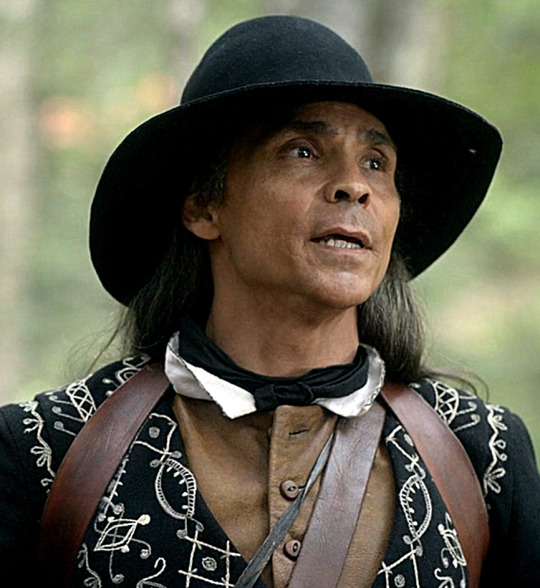
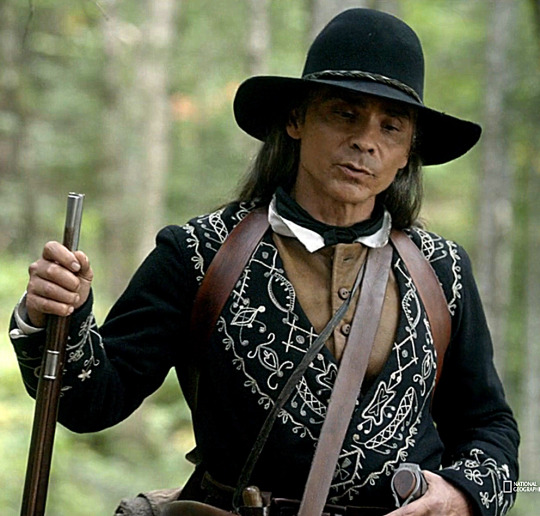


Wanted a better look at the embellishment on Yvon’s jacket, so I took some caps! Some general observations:
The jacket is basically in the cut of a tunic, falling to about midthigh and with the left breast wrapping over the right so that the sides of the lower skirt-like part overlaps.
Symmetrical decorative patterns are found around the collar (meeting in a shallow vee over his upper back and gently tapering in front to form lapel shapes that terminate around the waist, covered by his belt) and also around the sleeve cuffs.
The prevailing motifs seen in these designs differ between collar and cuffs. The ones around the collar seem abstract: curving linear and geometric patterns. The cuffs, however, share the curving line style but are more representative, depicting floral/botanical elements.
I had initially wondered whether some of the round/raised bits might be beads rather than thread. I found some real close-up shots in which you can see the stitching, though, and it looks like the bits I thought might be beads are just loops or whorls of thread, so I think I can confirm that it’s all thread embroidery.
I’m putting the rest of this under a cut because it’s quite long, but: basically, I was interested in the style of decoration on his jacket, particularly the floral aspects, and attempted to do some historical research. I honestly was not as successful as I would’ve liked, and this post has actually been sitting in my drafts for almost two weeks now because I kind of got stuck. But on reflection, I still do want to share the screenshots as references, my observations, and at least the gist of what I looked into and what I found.
So! Under the cut: rambles about what interested me and what info I was looking for, links to the work of modern Ojibwe and Métis artists, and also a brief note on Yvon’s rifle strap, which I think is quite interesting as well!
Basically, when I was initially collecting the above images, my interest was particularly piqued by the floral decorations on the cuffs. The show identifies Yvon as Anishinaabe, and Zahn / Nat Geo have identified him specifically as Ojibwe, and I had a vague memory of reading at some point that Ojibwe art is particularly associated with floral designs. Floral designs not being solely unique to Ojibwe art among indigenous arts, and Ojibwe designs not being solely limited to floral ones, but a strong association nonetheless. I think most famously this takes the form of colorful, intricate embroidery with tiny glass beads:

(image source: Native American Artist-in-Residence: Jessica Gokey)
This is often done on black velvet or, as in the case of some of Gokey’s work that I saw, on black broadcloath, which I would say is probably about the same type of fabric Yvon’s jacket is made of — a plain, dense, sturdy wool. Although my understanding is that Ojibwe didn’t begin using colored glass beads of this sort until they acquired them via trade with Europeans in about the 19th century, beads made of other materials would, of course, still have been available in Yvon’s time, and I was still curious about whether the designs themselves on his jacket accurately reflect authentic patterns and motifs used by Ojibwe people. What was clothing and decoration like among Ojibwe and Anishinaabe people in the 17th century? What styles and materials were used? Are the elements in Yvon’s embroidery more generic, or are they recognizably specific in style to his culture, etc.?
And so I began with the Wiki-ing and the Google Scholaring and the skimming of articles. Unfortunately, a lot of the most promising-looking sources were only available as printed books (some of them quite expensive, too), so I didn’t have access to them, but from the articles I was able to browse, I did learn some relevant things. I found sources saying that before glass beadwork, Ojibwe decoration did use other types of beads and also used embroidery, which tracks with what we see on Yvon. I found a number of sources saying that floral motifs specifically were introduced to people of the Northeastern Woodlands in the 17th century via contact with Europeans, particularly nuns, who brought with them their floral embroidered fabrics and their floral folk arts.
However...
Although there were plenty of mentions of Ojibwe beadwork and floral designs, and a good number of more modern examples, I had difficulty finding in-depth information that discussed it specifically in the context of Barkskins’s time period (or prior to European contact, either). Sources focusing on the art in later time periods might still be relevant to what Ojibwe decorative arts were like in the 17th century, but I just don’t know enough to know. The example images I found were of beadwork from the 19th century or later, and even then, they were buried in a slew of Pinterest results that I really don’t consider reputable sources, because sure, they might be legit, but they might also be completely mislabeled.
In general, I felt less than confident about what my searches turned up. This is a topic I know little about, have no personal or academic experience with (not being Ojibwe and not having formally studied anything relevant to this), and I’m wary of misinformation here because I know that indigenous people have spoken about seeing biased, simplified, and outright inaccurate info presented even by sources that should seem credible, like museums. Not to mention conflicting info. Remember I mentioned I read about floral designs being introduced (or at least popularized) by European art? And yet I also saw other sources rejecting this idea that Ojibwe floral motifs have their roots in colonizers’ art rather than simply in drawing their own inspiration from nature. In general, I just didn’t feel confident that I had the insight or education necessary to evaluate my sources or synthesize conflicting info, and my brief, superficial research didn’t seem reputable or interesting enough to shed any particular light on Yvon’s clothing. So I basically put this post aside.

(image source: Native American Artist-in-Residence: Sarah Agaton Howes)
But ultimately, I still want to highlight Yvon’s embroidery, even if only from an aesthetic, costume-detail perspective, and I also want to share some of the lovely videos showing the work of modern Ojibwe artists I came across while I was looking all of this up! Here’s another link to this video featuring the work of Jessica Gokey, which I inserted near the top, and here’s one in which Greg Bellanger discusses some of the history and process of his art. In this interview, Sarah Agaton Howes brings up the idea of Ojibwe floral designs as a historical means of teaching about medicines and preserving that cultural knowledge, especially in times when passing down such knowledge was suppressed. I thought that was very interesting and am kicking myself because I did actually look briefly at a thesis extract on Ojibwe botanical/medicinal knowledge, but now I can’t find it again. I also enjoyed this shorter video with Howes as well. And this video featuring the work of Delina White gives us some examples of these floral designs primarily as embroidered thread, like on Yvon’s clothing, rather than as beadwork:
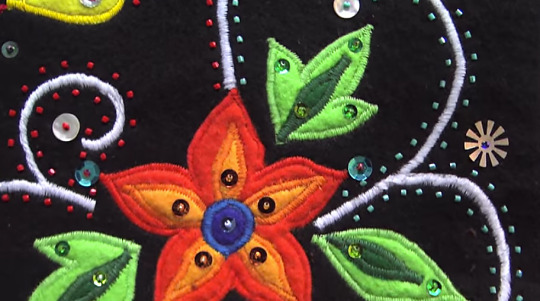
(image source: Delina White)
The final video I’ll link is this one, which is about Métis floral beadwork rather than Ojibwe. I don’t know how similar/different the two styles are (nowadays or historically), but since Métis share roots with Ojibwe and Anishinaabe people, and since Métis culture developed out of the setting, cultural interactions, and approximate time period of Barkskins, I thought it still relevant enough to rec here. Not to mention that it’s just pretty and I wanna rec it. All of these videos offer a lot of interesting information and perspective on the craft itself as well as on the history and tradition.

Before I go… One little costume detail I do feel reasonably confident offering my own speculation on is that the decoration on Yvon’s rifle strap appears to be quillwork — porcupine quills dyed and shaped into designs. I could be wrong, but the texture, colors, and pattern look very similar to the examples I’ve seen, and it’s an art form that would certainly have been established, culturally relevant, and available to him in this time period. So that’s the tiny bit of original input I’ll contribute to this post!
In general, I think the whole Barkskins team — costume design very much included — has shown that they put a tremendous amount of research and thought into the design and construction of this show. I’m sure Yvon and his costume were no exception. And I love the overall look!
#barkskins#yvon#zahn mcclarnon#barkskins meta#i heard y'all wanted more yvon meta! so i finished this up#op#history#costume
92 notes
·
View notes
Text
MEET THE MUSE

► Name ➔ “Greetings, my name is Zelda, it is a pleasure to meet you...!”
► Are you single ➔ “Goodness me, quite the question to start off with, hm? Though courting is nothing unusual for those aiming for the crown, I’ve not sought out any relationships...”
► Are you happy ➔ “Ahah, am I? Though it is easier to just say yes and move on...”
► Are you angry? ➔ “Eh? Not to my knowledge, as I do not have any reason to be angry...”
► Are your parents still married ➔ “Though they are no longer within this realm, I would like to believe their love for each other remained even within the Spirit Realm...”
NINE FACTS
► Birth Place ➔ “I believe it was somewhere within the Lanayru Province, though I could not tell you where, unfortunately... quite funny how it wasn’t within Central Hyrule...”
► Hair Color ➔ “Ah, it is blonde... though it is pretty light...”
► Eye Color ➔ “Blue, quite the common color here...”
► Birthday ➔ “... Fall Equinox is finally here...! My birthday is quite a bore, let us discuss more about the wonders of Fall instead...!” (September 19th for those wondering sadhbjkadsgh)
► Mood ➔ *Radio static sounds* “Hmm? My apologies, do you mind repeating the question once more I did not quite catch it...”
► Gender ➔ “Female...”
► Summer or winter ➔ “Neither of those seasons, I am afraid... though if I had to choose I suppose summer, the winters can be quite harsh here at times. It is the test of the gods... or so my ancestors among others from the Spirit Realm would say...”
► Morning or afternoon ➔ “Ahah, though very un-princess like of me to admit, I do like sleeping in more, waking up in the early hours of the day has made mornings quite unappealing to me, so I prefer the afternoon. It is hard for me to sleep in given my duties, I envy those who spend the whole day asleep ahahah...”
EIGHT THINGS ABOUT YOUR LOVE LIFE
► Are you in love ➔ “I do not believe so, though I love my people, family, and friends I have yet to experience love in that form. Perhaps someday I will but I am in no rush... romance novels and plays more than make up for my lack of romance ahah...!”
► Do you believe in love at first sight ➔ “No. Surprising, is it not? But as romantic as that may sound within the confines of books, I do not believe love works like that. Love is... to me, love is a bond that takes time for it to develop and flourish. The more you wish to spend time with them the more you realize your feelings for them. When you look at it that way, I believe it is far more beautiful than believing you are in love when you first spot the person, looks are superficial...”
► Who ended your last relationship ➔ “I was never in one, ahaha...!”
► Have you ever broken someone’s heart ➔ “As in rejection? I do not believe so, as nobles aiming for my hand in marriage in general do not harbor any feelings towards me, at least I can only assume such is the case, with that assumption in mind it certainly makes rejecting their offers less guilt inducing...”
► Are you afraid of commitments ➔ “It would be a scary day in Hyrule if a ruler were to show fear towards such sentiments, no...? I am not afraid, no. Though, truthfully there’s little I fear...”
► Have you hugged someone within the last week? ➔ “Ahaha, I am positive that the maidens, the oracles, and Link can all vouch for me when I say that I can be quite affectionate towards my friends! I always give them hugs whenever I greet them... not too long ago I hugged one of them when they came over for a short audience...”
► Have you ever had a secret admirer ➔ “Well, it is no longer a secret to anyone when you accidentally found their poem dedicated to you... for their sake I shall not reveal their identity... that being said, aside from them I do not believe I have had any...”
► Have you ever broken your own heart? ➔ “What an interesting question...”
SIX CHOICES
► Love or lust ➔ “Love of course...”
► Lemonade or iced tea ➔ “Apple cider! Oh? Is that considered cheating? My apologies... I suppose iced tea sounds wonderfully refreshing to have during a hot summer’s day, I can imagine myself with a glass after wondering through the graveyard...”
► Cats or Dogs ➔ “Oh I just adore both but cats mostly, they are quite adorable and each have such fun personalities...!”
► A few best friends or many regular friends ➔ “Few best friends, I do not mind meeting with new people but bonds are important to me, I would rather have meaningful bonds with someone rather than friviolous friendships...”
► Wild night out or romantic night in ➔ “A romantic night in... beneath the moonlight... with a wonderful dinner...”
► Day or night ➔ “Night time, it is easier to contact the dead during this time believe it or not...! At least, within my dreams...”
FIVE HAVE YOU EVERS
► Been caught sneaking out ➔ “By the goddesses I cannot begin to tell you the amount of times the guards or Impa have caught me, it is rather embarrassing whenever they would catch me. Just thinking about all those times... goodness, I am sure my face is red now...”
► Fallen down/up the stairs ➔ “Perhaps when I was younger but now...?”
► Wanted something/someone so badly it hurt? ➔ "It is a universal feeling I believe we can all relate to...”
► Wanted to disappear ➔ “No...”
FOUR PREFERENCES
► Smile or eyes ➔ “Ah, it is the eyes I tend to focus! As the saying goes they are the windows to the soul, though I believe that both these things can overlap as a smile can only make their eyes shine with more beauty...”
► Shorter or Taller ➔ “It matters not what their height is...”
► Intelligence or Attraction ➔ “I-intelligence? Hm, yes, that sounds about right...” HOW DOES ONE ANSWER THIS WHEN SHE LIKES WHOLESOME HARDWORKING IDIOTS???
► Hook-up or Relationship ➔ “Hook-up...? My apologies, I do not understand the meaning of this word is it something from a more modern era? But considering the other choice, I believe I can guess what it means... if my guess is correct then I would prefer relationship...”
FAMILY
► Do you and your family get along ➔ “Of course, although... no, nevermind that. It is in the past now. But believe it or not, I have not made contact with either my mother or father since their deaths. But if I could, then I would tell them that... ah, excuse me, it would seem sentimentality has taken over. P-please, do not mind me go on with the next question...!”
► Would you say you have a “messed up life” ➔ “Ahaha,” *MONOTONE LAUGHTER*
► Have you ever ran away from home ➔ “Goodness no.”
► Have you ever gotten kicked out ➔ “... that... I do not believe that is possible now considering my status as sole ruler... unless I were to kick myself out...”
FRIENDS
► Do you secretly hate one of your friends ➔ “Eh? No, I could never! To suggest such a thing... how awful...”
► Do you consider all of your friend’s good friends ➔ “Yes, naturally, I love them all with my heart...” They’re all she has now ;v;
► Who is your best friend ➔ “Ah, I do feel bad for choosing but... Link... he has been through it all... despite our distance our friendship will never wane away, that is what I believe...”
► Who knows everything about you ➔ “That would be... hm... troublesome if someone were to know everything about me.” *sweats while looking at Impa* “I do not even think Link knows too many things about me and vice versa, it is best to keep certain things concealed within the darkness when you live a life like ours...”
ᴛᴀɢɢᴇᴅ ʙʏ: no one i stole it from @cadcnce when he demanded for others to steal and i was like *smirk emoji*
ᴛᴀɢɢɪɴɢ: BE A PIRATE!!!
#dash games.#i actually only have one draft to do and then i'm all caught up *Stares at hands*#BUT THIS IS FUNNY BECAUSE THIS IS JUST ZELDA#going 'welp' and then shutting her mouth shut with duct tape before she can become emotionally vulnerable#hate this hate her hate how she closes up like a calm
2 notes
·
View notes
Text
Oxyura

White-Headed Duck by Benutzer Else, CC BY-SA 3.0
PLEASE SUPPORT US ON PATREON. EACH and EVERY DONATION helps to keep this blog running! Any amount, even ONE DOLLAR is APPRECIATED! IF YOU ENJOY THIS CONTENT, please CONSIDER DONATING!
Name: Oxyura
Status: Extant
First Described: 1828
Described By: Bonaparte
Classification: Dinosauria, Saurischia, Eusaurischia, Theropoda, Neotheropoda, Averostra, Tetanurae, Orionides, Avetheropoda, Coelurosauria, Tyrannoraptora, Maniraptoriformes, Maniraptora, Pennaraptora, Paraves, Eumaniraptora, Averaptora, Avialae, Euavialae, Avebrevicauda, Pygostylia, Ornithothoraces, Euornithes, Ornithuromorpha, Ornithurae, Neornithes, Neognathae, Galloanserae, Anseriformes, Anseres, Anatoidea, Anatidae, Oxyurinae
Referred Species: O. australis (Blue-Billed Duck, extant), O. jamaicensis (Ruddy Duck, extant), O. ferruginea (Andean Duck, extant), O. leucocephala (White-Headed Duck, extant), O. maccoa (Maccoa Duck, extant), O. vittata (Lake Duck, extant), O. vantetsi (New Zealand Stiff-Tailed Duck, extinct), O. doksana (extinct), O. zapatanima (extinct), O. bessomi (extinct)
Oxyura is a genus of extemely distinctive and, frankly, bizzare ducks from all over the world, known from an expansive fossil record of relatives as well as members of the genus. The stiff-tailed ducks appeared sometime in the Paleogene, and diversified extensively during the Miocene, with many members of the family found all over the globe - as we have seen here at ADAD. This genus in particular first appears in the Miocene, potentially in the Czech Republic, though that species is dubious. Other species are known from the Pliocene of Mexico, and the Pleistocene of the southwestern United States that might actually be an evolutionary precursor to the modern Ruddy Duck. The New Zealand Stiff-Tailed Duck, from the Holocene of New Zealand, was closely related to the Blue-Billed duck but one-tenth the size, and probably went extinct due to human overhunting. These birds are united in having long, stiff tail feathers that go up when the bird is resting, giving these dinosaurs a distinctive appearance. They have large, swollen bills, and are freshwater diving ducks. They have legs that are set far back, so they are very awkward moving on land, and thus rarely leave the water. They are found all over the world, as shown below:
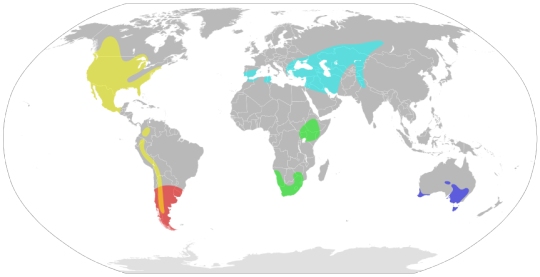
By Ninjatacoshell, CC BY-SA 3.0 (Red: Lake Duck, Yellow: Ruddy Duck, Green: Maccoa Duck, Turquoise: White-Headed Duck, Blue: Blue-Billed Duck)
Though the ranges of each individual species rarely overlap. They have a lot of interesting displays, such as making drumming noises from throat sacs, throwing their heads, and popping up crests. They spend so much time in the water that their plumage is often the most important thing keeping them comfortable.
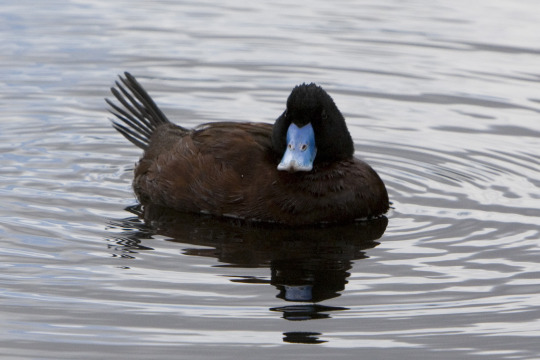
Blue-Billed Duck by Valorix, CC BY-SA 3.0
The Blue-Billed Duck, O. australis, is the only species known from Australia. They are fairly small, growing up to 40 centimeters in length. The males have blue bills that become very brightly colored during the breeding season, and also become ruddy brown at this time. The females have black feathers year round. These birds are not only the only member of the genus known from Australia, but only live in Australia, in temperate wetlands in large numbers. They seem to be near threatened, due to drainage of wetland systems, flood migration, and vegetation loss. There are conservations ongoing for the bird, including maintaining water flows. A shy species, it’s difficult to parse out much of its behavior in the wild - its average lifespan is unknown, though probably less than 10 years. They mature after 12 months from hatching, and many eggs are laid in a clutch.
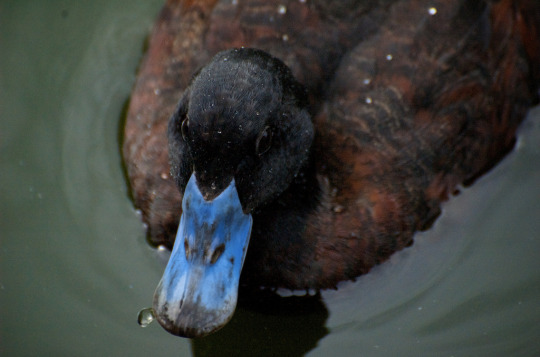
Blue-Billed Duck by Helena Bella, CC BY-SA 3.0
Given that this is a stiff-tailed duck, it is a very awkward mover on land, having difficulty walking much like a penguin. They, thus, spend almost all their time in the water, in flocks of many hundreds far from the shore. They breed in deep, freshwater swamps, using dense vegetation for cover. During the breeding season the large flocks tend to disperse, with the females taking care of eggs and males only remaining for courtship. They dive under the water when threatened, and rarely fly. They are omnivorous birds, feeding on invertebrates, seeds, buds, and fruit. They sift through the mud with their beaks and feed primarily on small water animals like dragonflies, water beetles, and larvae. They seem to migrate from breeding swamps of the inland to rivers during the non-breeding season. They seem to have facultative brood parasitism, with females occasionally dumping their clutches in nests other than their own. The ducklings are of adult size at eight weeks, and are relatively independent upon hatching.

Ruddy Duck by Dick Daniels, CC BY-SA 3.0
The Ruddy Duck is the Stiff-Tailed Duck species known from North America, found throughout the United States and Mexico, even extending up into Canada, with a distinct subspecies population along the Pacific Coast of South America. They are considered not threatened with extinction. They are small duck, about 34 to 43 centimeters in length, with scoop-shaped bills and long stiff tails usually held above water. The males have brown bodies and bright blue bills like their Australian cousins during the breeding season, and females are brownish with grey bills. They have dark tops of the wings that are visible while flying, though they don’t fly often.
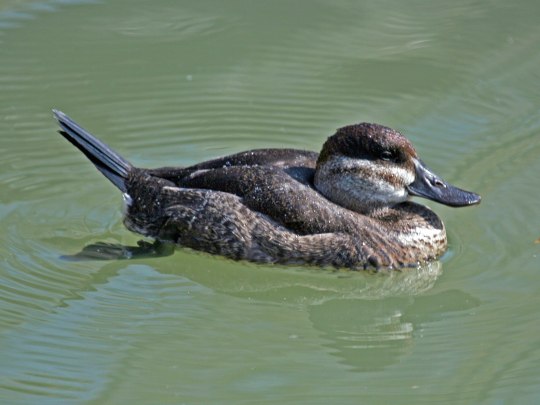
Ruddy Duck by Dick Daniels, CC BY-SA 3.0
These birds live primarily in marshy lakes and ponds, nesting in dense vegetation near the water. Females build nests out of grass, hiding it in tall vegetation from predators. They have about 5 to 15 ducklings per brood, and they are migratory birds following the range of unfrozen lakes and ponds. They’ll dive underwater to feed upon seeds, roots, insects, and crustaceans. Unfortunately, they are an invasive species in Great Britain, though efforts to remove their populations have bene mostly successful.
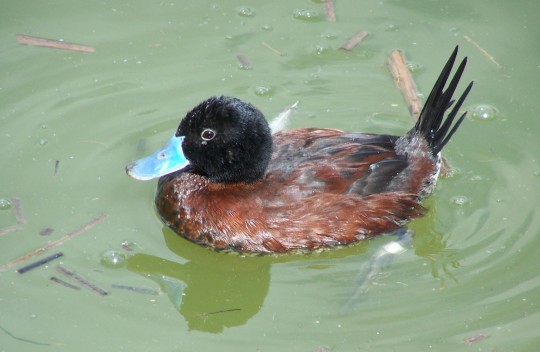
Andean Duck by Milardello, in the Public Domain
The Andean Duck is also known from the Andes Mountains in South America, and is also not threatened with extinction. They are small birds, with similar coloration to the other members of the genus. They have short, thick necks and slightly peaked heads, giving their round bills a superficially more normal appearance. They are more dull in the winter, with females being brownish year round. It’s face is all black, and it’s generally larger than the Ruddy Duck, making the two species distinct. They live in marshy lakes and ponds along the Andes Mountains, and nest in dense vegetation. They feed upon seeds, roots, insects, and crustaceans by diving into the water.
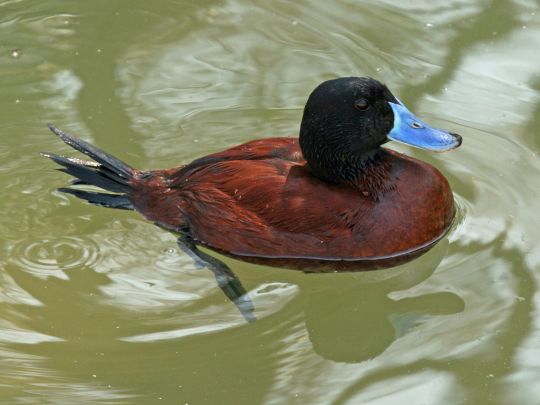
Lake Duck by Dick Daniels, CC BY-SA 3.0
The Lake Duck also exists in South America, entirely within the southern part of the continent, in the southern portions of Chile, Argentina, and Uruguay. They are not threatened with extinction. They live in lakes throughout this area and are notable for something very distinctive: they have the longest penis in relation to body length of all vertebrates, and the largest avian reproductive organ. The penis is coiled up when not erect, and when erect it is the same size as the animal (though usually is kept shorter). As these birds are very promiscuous, this penis probably evolved due to competitive pressure in mating, utilizing the length and shape to remove sperm from previous birds. Though they attempt to force copulation on the females, the females are able to control their bodies through their corkscrew vaginas, which prevent successful fertilization from coerced copulation. This rather violent mating system is, unfortunately, common to most ducks.
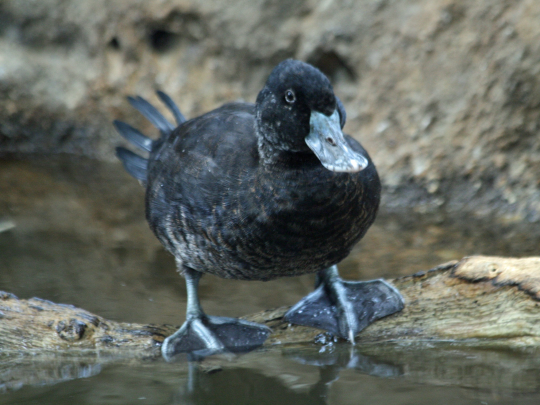
Maccoa Duck by Sandy Cole, CC BY-SA 3.0
The Maccoa Duck is the African species of this genus, and is unfortunately vulnerable to extinction. It is known in two areas - Sudan, Ethiopia, Zaire, and Tanzania; and then Zimbabwe and South Africa. They live in shallow fresh waters, as well as brackish and salty lakes during the winter. The males are brownish, with black heads and blue bills. The females have grey bills and black bodies.

White-Headed Duck by Miss Tanya Love, CC BY-SA 3.0
The White-Headed Duck is our final species, and the only one naturally known from Eurasia. It is found in Spain and North Africa, with very large populations in Greece, Western and Central Asia. They live in large bodies of open water such as lakes, ponds, and artificial water bodies, using dense aquatic plants for shelter and nesting sites. They dive and swim under water to feed on a variety of food items, and rarely fly. The females have dark bills and dull coloration, while the males are grey, with white heads and distinctive, fat-looking blue bills (the females also have the fat looking bill, it’s just grey). They are about 43 to 48 centimeters in length, making them rather long for the genus. Unfortunately, due to large reductions in populations from habitat loss, hunting, and the invasive ruddy duck, it’s considered endangered. Conservation efforts are ongoing.
Sources:
https://en.wikipedia.org/wiki/New_Zealand_stiff-tailed_duck
https://en.wikipedia.org/wiki/Stiff-tailed_duck
https://en.wikipedia.org/wiki/Blue-billed_duck
https://en.wikipedia.org/wiki/Ruddy_duck
https://en.wikipedia.org/wiki/Andean_duck
https://en.wikipedia.org/wiki/Lake_duck
https://en.wikipedia.org/wiki/Maccoa_duck
https://en.wikipedia.org/wiki/White-headed_duck
#oxyura#stiff-tailed ducks#birds#dinosaurs#ducks#blue-billed duck#ruddy duck#andean duck#white-headed duck#maccoa duck#lake duck#new zealand stiff-tailed duck#oxyura australis#oxyura jamaicensis#oxyura ferruginea#oxyura leucocephala#oxyura maccoa#oxyura vittata#oxyura vantetsi#oxyura doksana#oxyura zapatanima#oxyura bessomi#dinosaur#birblr#palaeoblr#factfile#paleontology#prehistory#prehistoric life#biology
74 notes
·
View notes
Note
Difference btw Fe and So? What makes the SOC variant socially, and the Fe extrovert feeling, given the way these two overlap?
Well if you want to go to the pure root of things, the ideology between MBTI and instinctual variants is the biggest difference between the two. Instinctual variants basically deal with humankind's survival strategies. I'd say the social subtype is the most... Human? Social variants find security and ensure their survival through finding their place within communities. They connect with others, and in turn, groups because humans are more likely to survive, thrive, and improve as a team. Fe, and in extension, MBTI, deal with the way a person functions. MBTI is the behavioral equivalent of a machine's blueprints. It tells us each 'part' a human has, the way it functions, and the way it interacts with the human's other 'parts.' Moving onto Fe, Fe moves to ensure social efficiency within its environment. Like how Te will delegate to make the workplace a smoothly running machine, Fe makes enforces social norms and convinces people to adapt to such in order things are harmonious and moving forward. Granted, looking at the two, they seem pretty similar? At least behaviorally speaking. Which is why, I'd assume, most judgers will be social variants due to their nature to control the happenings of their outer environment. At least, I would assume judgers are more likely in comparison to perceivers. However, the difference between the two again is that social variants socialize because it's subconsciously essential to their survival and thriving in life while Fe socializes because they want to establish social order. Unfortunately, I cannot give you any in depth differences because I'm the only so-blind FJ I know. And because I am, the subject of whether I mistyped myself or not comes up a lot in my mental musings. But if I am one, the differences is within motive. I Fe because it heightens my ability to sp better. And in the same sense, my use of Fe is very... immediate and not long term in the slightest. I'll Fe in a social situation, aka ensuring peace and quelling awkward atmospheres and whatnot, but once I leave the room, I have no urging to revisit and upkeep that social atmosphere. It's like I'm talking to a bunch of faceless people. I won't make an effort to remember their names or their faces, I'll blatantly avoid them if I see them in public again... Social variants need to have a place in a community. You see this on Tumblr a lot. People that interact a lot with others and try to upkeep that acquaintanceship are social variants. People that talk to you a lot and try to keep in contact after you spoke/exchange numbers once are social variants. They can be edgy af and say they don't care about the opinions of others and whatever other crap, but that honestly means crap. If they attempt to upkeep a relationship that really has no basis, they're probably a social variant.I suppose that's what it boils down to? The amount of work you choose to put into your relationships. Introverts and FJs that feel obligated to talk to others, form friendships, talk to these people regularly whether they like them or not... These are social variants. FJs that interact when they have to, focus their longterm Fe only on their close friendships, and show in thought and action that they have no desire to connect to others superficially are socially blind. But I mean... Neither are necessarily bad when you look at the long term stuff? Social variants typically have no qualms connecting with their other peeps to get jobs, supplies, etc. Y'all have a greater chance of becoming rich. And social blind people have a greater chance of surviving a zombie invasion bc we'll be smart enough not to gather huge groups. So we all gots stuff going for us and stuff. uwub
#hopefully this makes sense i... highkey wrote this over the past few days#bc i was distracted with marathoning p5....
235 notes
·
View notes
Quote
The skin works amazingly. But you have to take care to avoid damaging it seriously. Find out more about the internal processes that involve the ...
How we choose to inhabit our own skin is a matter of each person, but knowing how the creatures of nature have developed different types of dermis is an amazing issue. The sturdy crocodile skin is so full of sensors that it can perceive its prey while swimming in the distance. And the body of the sperm whales is practically impenetrable thanks to a layer of skin that can be up to 35 centimeters thick. Comparatively, our disadvantage is significant, but just because the material that covers our body is more fragile does not mean that it is less complex.
The skin, the largest organ in the human body, is in a state of permanent regeneration. The tiny adult stem cells located in the outermost layer, the epidermis, produce new cells to replace those we lose by scratching ourselves with minor injuries (we lose about 400 million of these cells every day). By suffering deeper cuts, our skin's repair system activates and sets in motion four phases that overlap each other.
Platelets are the first to enter the scene and block the area to stop bleeding. Meanwhile, the area becomes inflamed as the cells responsible for repairing the injury accelerate its passage to the affected area. Then it is the turn of structural work. As with placing cement to solidify a house, a matrix is constructed that shapes the skin's dermal and epidermal layer. In a healthy body, these first three stages should be completed in a period of three weeks during which the small wound closes. After this process, specific cells are responsible for smoothing and softening the area. This fourth phase is known as remodeling and, like the renovation of a house, it can be a prolonged process that in some cases can extend for years.
In spite of how surprising the system is, it only seems to capture our attention when it does a sloppy job, it takes a long time to recover or does not meet the expected. People who suffer from diabetes or other chronic diseases may have wounds that refuse to heal. And as we grow, the regeneration and repair capacity of the skin is reduced. The cells that produce new skin fail to keep up, and the skin becomes thinner.
There is a positive aspect, however. The older the person is, the lower the likelihood of thick scars. "This is one of the great mysteries of human biology," says Dr. Vincent Gabriel, an assistant professor of pediatrics, surgery and clinical neurosciences at the University of Calgary. Although children can recover quickly from an injury, they have a greater propensity to develop scars that are thicker than adults, which may seem unfair to the tendency to fall that reigns among the smallest.
And that is not the only mystery. Recent research has shown that the skin has olfactory receptors. In a study at the Ruhr University in Bochum, Germany, it was discovered that certain synthesized aromas of sandalwood were accelerating the process of generating new skin cells in the laboratory. By exposing skin cell samples to these aromas over a period of five days, they proliferated at a faster rate compared to those that did not experience exposure. Researchers believe that certain aromas can play some kind of role in the healing process.
In extreme cases, however, more drastic interventions are needed. In recent years, plastic surgeons have improved techniques for performing ambitious reconstruction procedures, such as the removal and reapplication of large sections of tissue to cover lesions, including muscles, bones and blood vessels. Some have even performed facial transplants, in which the entire face of a deceased person is transferred to a patient disfigured by an injury. But in most cases, the standard procedure is a medium-thick skin graft that involves removing a thin sample from another area of the patient's body to cover a wound.
Este proceso no es para nada perfecto. “Todos mis pacientes con injertos necesitan seguimiento por mucho tiempo”, afirma Gabriel. “Prácticamente nunca crece vello en ese sector de la piel. Tiene una textura más rígida y frágil, y esa piel es más propensa a desarrollar heridas a partir de traumas de poca relevancia”. Su equipo está estudiando una célula madre dérmica adulta encontrada en el folículo piloso que puede ayudar a mejorar los injertos.
Another issue is the damage patients suffer when they experience scratches on large portions of healthy skin. Dr. Marc Jeschke, head of the burn division of the Sunnybrook Health Sciences Center in Toronto, tries to find solutions to these unfortunate events. His team collaborates in the development of a 3D printer that will use only a small sample of a patient to print new skin. So far, the only ones who walk through life with printed skin are rodents. But humans could be next in the not so distant future.
The discovery
The scars are the result of an excessive repair process, they appear when certain cells called fibroblasts produce an excessive amount of matrix during the skin repair stage. Whether they originated from a mischief or a risky outdoor adventure, scars are considered emblems of honor. However, in more severe cases, they can cause anxiety, depression or fear of interacting with the outside world in traumatized patients.
For years, scientists have tried to develop treatments for hypertrophic scars and have failed in their attempts. But Aziz Ghahary, a professor of surgery at the University of British Columbia, has developed a topical cream that contains a natural chemical capable of stopping the formation of such tissues. "The scars should be treated as soon as possible," says Ghahary. “We must tell the fibroblasts: 'Thank you very much for your help, they have already produced enough matrix. We don't need more repair. ” This cream, approved by the Canadian Department of Health for clinical trials in humans, should be applied to a recently repaired wound to prevent scar formation.
How to treat burns
While many think in degrees when we talk about burns (first, second and third grade), today scientists consider the depth of the lesion to differentiate the different levels of severity. Here we describe how to treat the different types of injuries.
Deep burns: these types of injuries hurt both layers of skin and can even damage fat, muscles and bones. The area may look carbonized and black in color, or adopt a white color and dry appearance. In general, a skin graft is needed to repair these lesions.
- Call an emergency or go immediately to the hospital.
- Cover the area with something clean and wet, such as a wet towel.
- Never attempt to remove items that have burned or immerse large burned areas in cold water.
- Raise the burned areas above the level of the heart.
Superficial and partially deep burns: the skin regenerates without leaving marks after superficial burns.
However, in the long term, they can have consequences. Sunburn can cause skin cancer. Partially deep burns damage the lower layer of the skin. They can produce blisters and the skin look red.
- Keep under fresh water for 10 to 15 minutes-
- Do not use ice, as it can be very cold and cause more damage.
- Cover the burned area with a bandage with sterile gauze. Never pierce blisters.
Click here for more tips
http://bestofftops.blogspot.com/2019/09/secrets-of-skin-mysteries-of-largest.html
0 notes